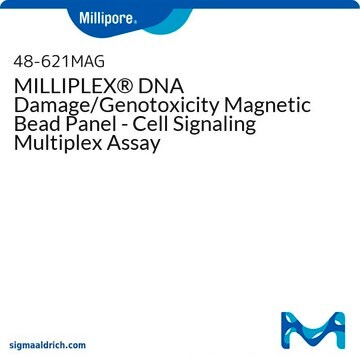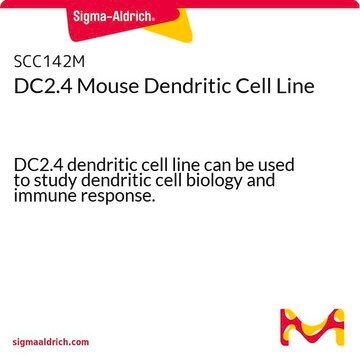Unfortunately, the original publication does not specify the sex of the mouse from which the microglia were derived. This information is not available.
SCC134
IMG Mouse Microglial Cell Line
Mouse
Sinônimo(s):
Immortalized microglial cells
About This Item
Produtos recomendados
Nome do produto
IMG Mouse Microglial Cell Line, IMG microglial cells recapitulate key features of microglial cell activation and may be used to study neuroinflammatory responses underlying Alzheimer′s disease.
fonte biológica
mouse
Nível de qualidade
técnica(s)
cell based assay: suitable
Condições de expedição
ambient
Descrição geral
Reference:
1. McCarthy RC, Lu DY, Alkhateeb A, Gardeck AM, Lee CH and Wessling-Resnick M (2016). Characterization of a novel adult murine immortalized microglial cell line and its activation by amyloid-beta. J. Neuroinflammation 13: 21
Descrição de linhagem celular
Aplicação
Immune Response
Inflammation & Immunology
Neuroscience
Neurodegenerative Diseases
Neuroinflammation & Pain
Qualidade
• Cells are tested negative for infectious diseases by a Mouse Essential CLEAR panel by Charles River Animal Diagnostic Services.
• Cells are verified to be of mouse origin and negative for inter-species contamination from rat, chinese hamster, Golden Syrian hamster, human and non-human primate (NHP) as assessed by a Contamination Clear panel by Charles River Animal Diagnostic Services.
• Cells are negative for mycoplasma contamination.
Armazenamento e estabilidade
Código de classe de armazenamento
12 - Non Combustible Liquids
Classe de risco de água (WGK)
WGK 1
Ponto de fulgor (°F)
Not applicable
Ponto de fulgor (°C)
Not applicable
Certificados de análise (COA)
Busque Certificados de análise (COA) digitando o Número do Lote do produto. Os números de lote e remessa podem ser encontrados no rótulo de um produto após a palavra “Lot” ou “Batch”.
Já possui este produto?
Encontre a documentação dos produtos que você adquiriu recentemente na biblioteca de documentos.
-
Are these microglia from male or female mice?
1 answer-
Helpful?
-
-
What kind of media would be best to use for this cell line?
1 answer-
The recommended medium for this cell line is as follows:
High Glucose DMEM (Cat. No. D6546)
10 % FBS (Cat. No. ES-009-B)
1X L-Glutamine (Cat. No. TMS-002-C)
1X Penicillin-Streptomycin Solution (Cat. No. TMSAB2-C) (optional)Please see the link below to review the product datasheet:
https://www.sigmaaldrich.com/deepweb/assets/sigmaaldrich/product/documents/145/570/20267563.pdfHelpful?
-
Active Filters
Nossa equipe de cientistas tem experiência em todas as áreas de pesquisa, incluindo Life Sciences, ciência de materiais, síntese química, cromatografia, química analítica e muitas outras.
Entre em contato com a assistência técnica







